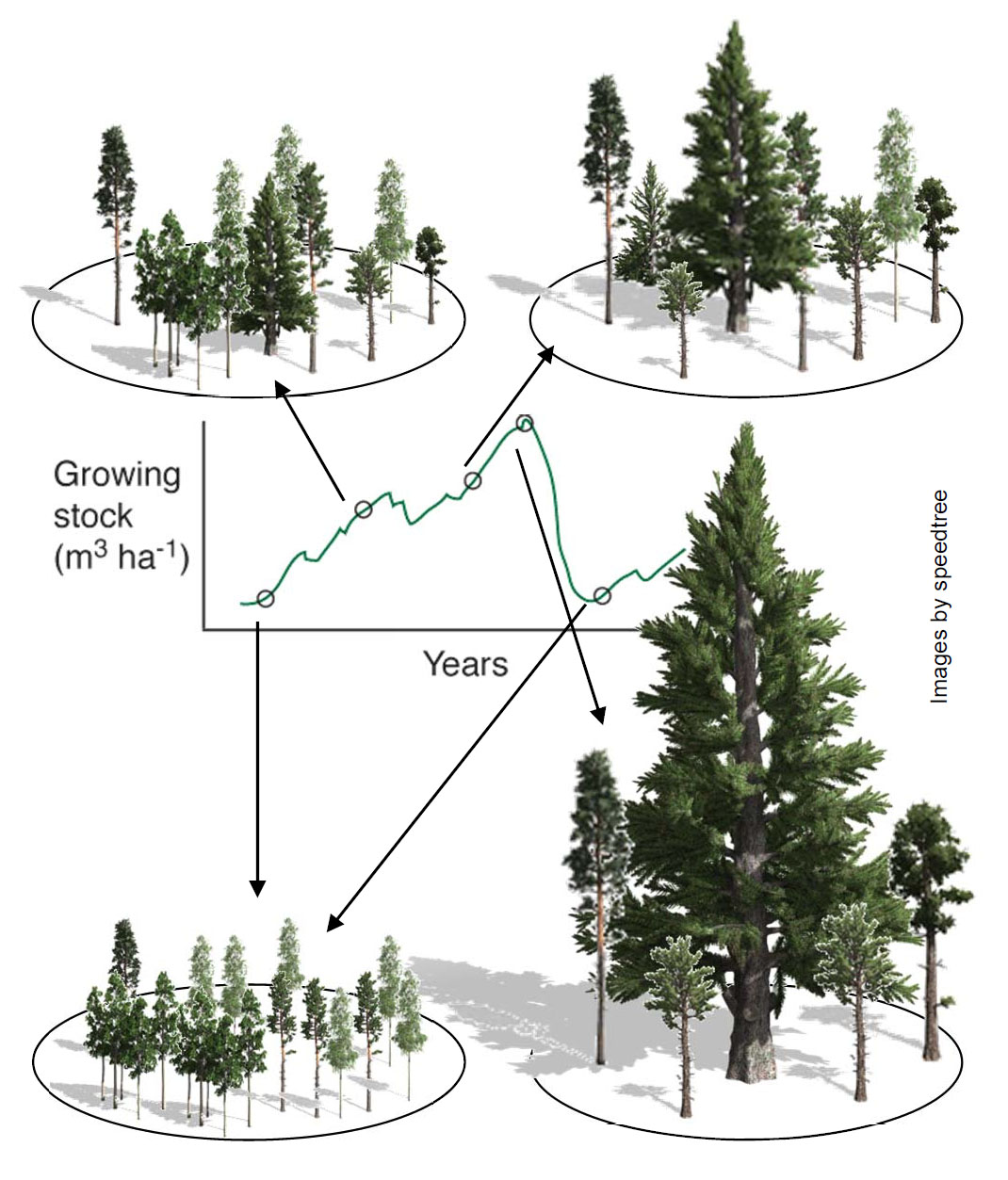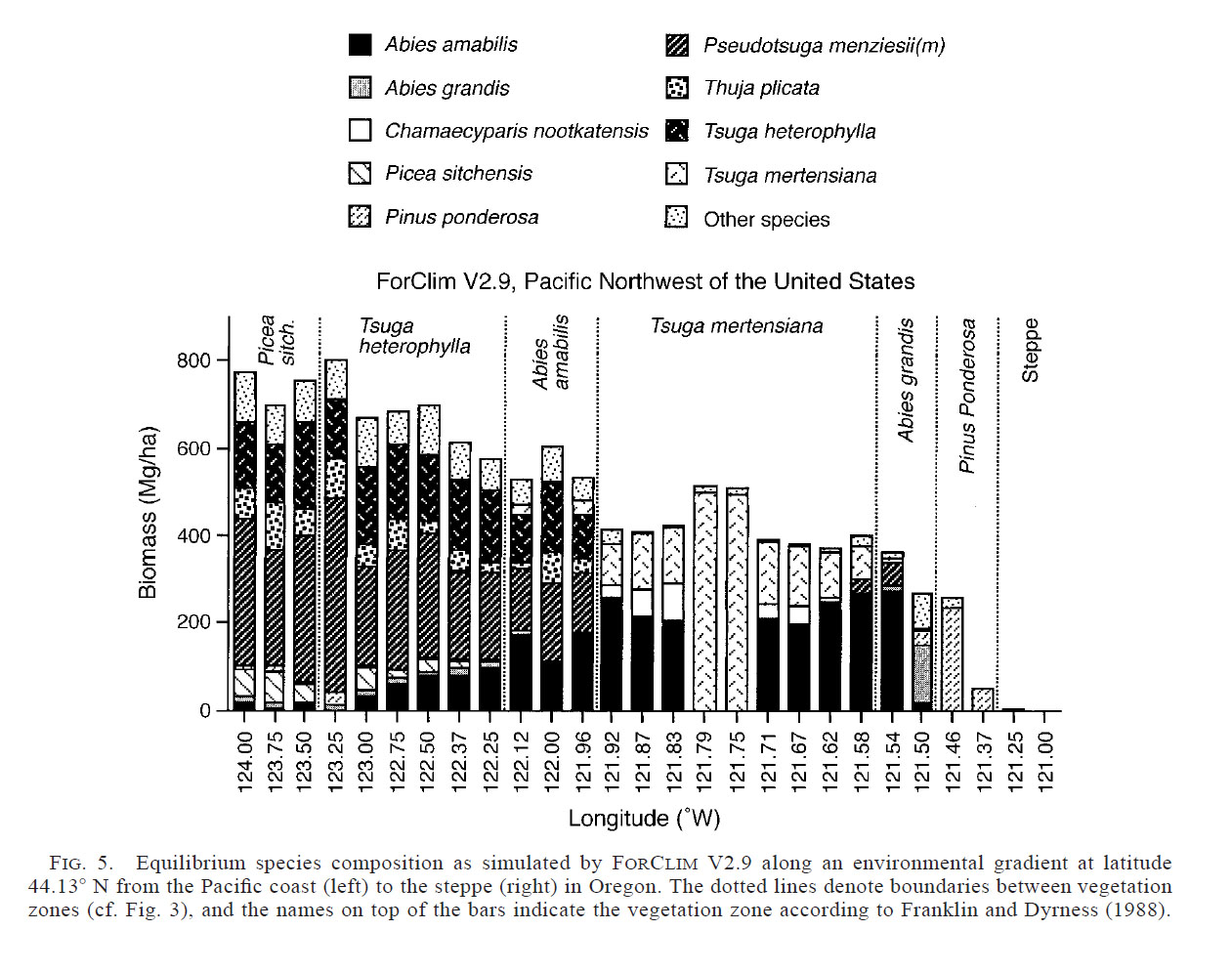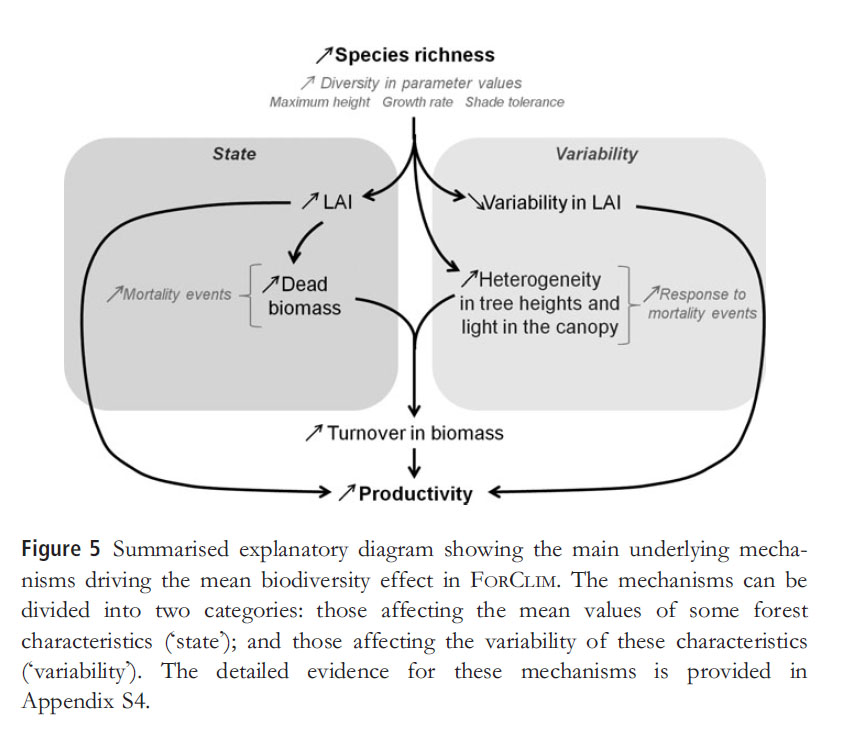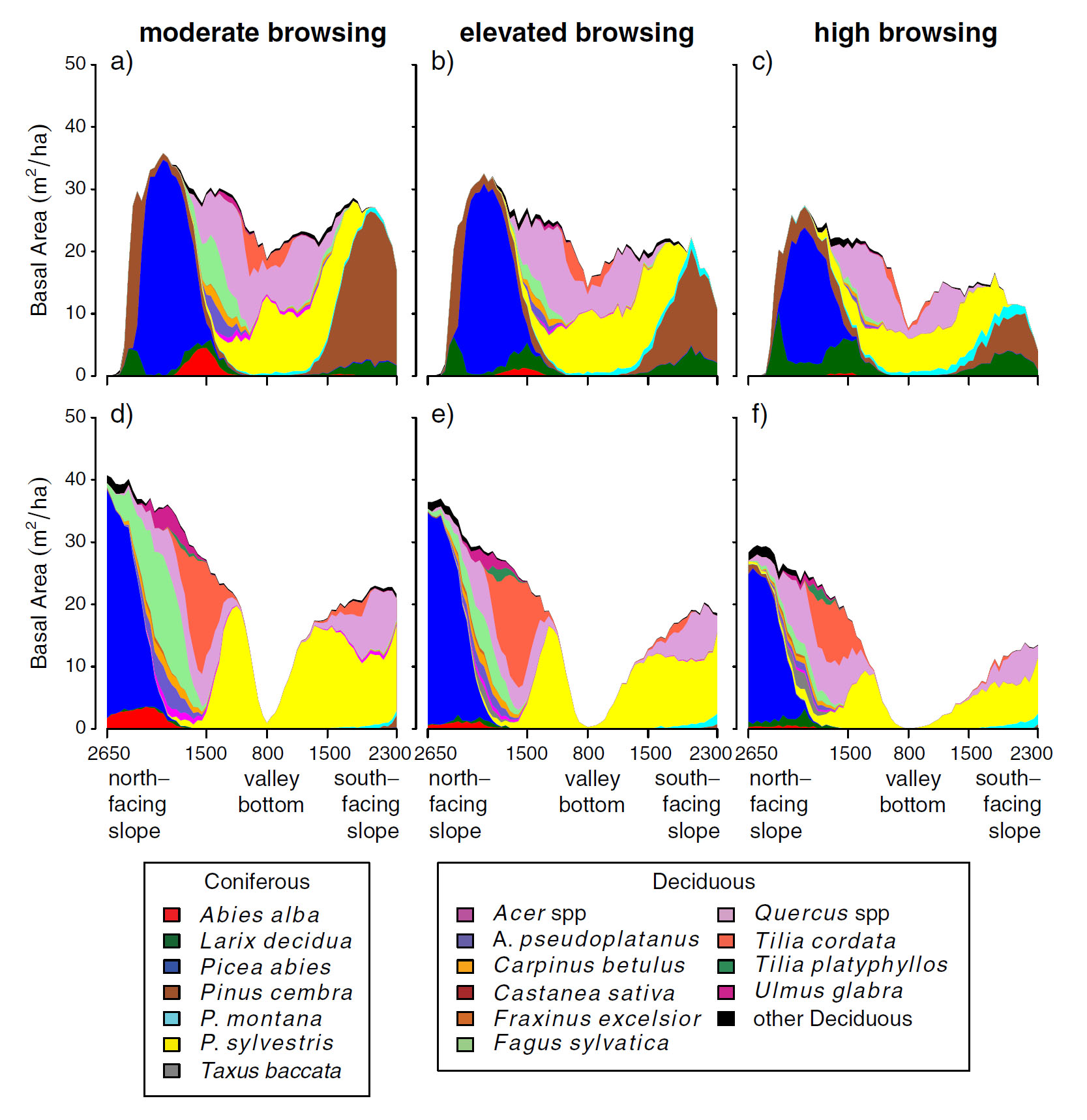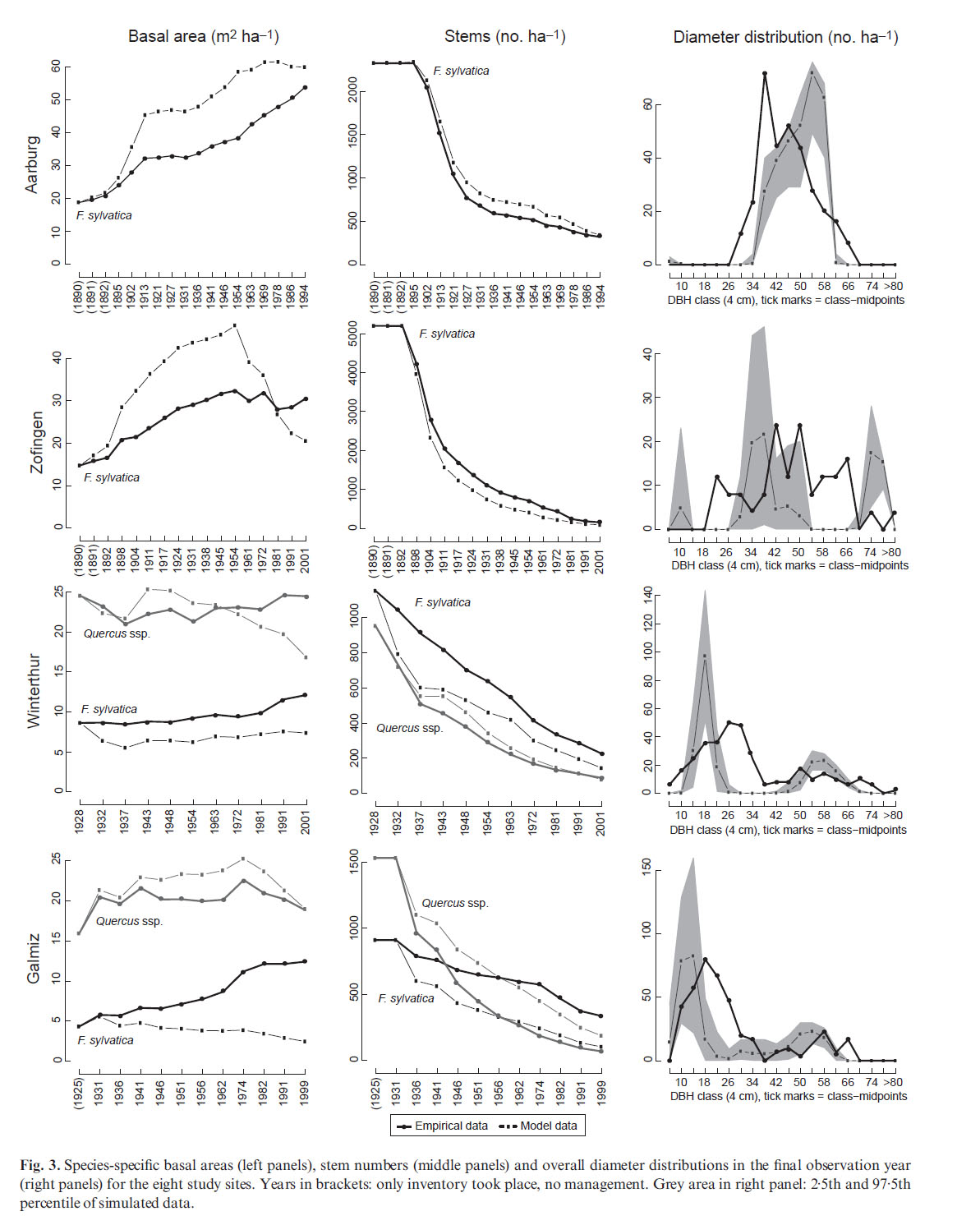Select one of the following links to be guided to specific chapters:
Overview
FORCLIM is a climate-sensitive forest succession (“gap”) model, developed to simulate forest stand dynamics over a wide range of environmental conditions.
Being a descendant of the FORECE model (Kienast 1987), in FORCLIM establishment, growth, competition and mortality of trees are simulated on small areas (‘patches’), normally with a size of 1/12 ha (ca. 833 m2). The approach of FORCLIM is to use only a minimum of ecological assumptions to capture the influence of climate and ecological processes on long-term forest dynamics (Bugmann 1996; Bugmann 1999). As a basic rule, it is assumed that there is no interaction between patches, implying that forest succession on a patch is independent of its neighborhood (Bugmann 2001). The simulation results from many patches (typically 200) are averaged to obtain the general succession pattern at the stand scale (Bugmann and Solomon 2000).
FORCLIM is currently parameterized for ca. 180 tree species dominant of temperate forests worldwide. The model has been tested comprehensively for the representation of natural forest dynamics of temperate forests of the Northern Hemisphere, with an emphasis on European forests . For example, FORCLIM results match time series data from growth-and-yield plots over 80-100 years remarkably well (Rasche et al. 2011), and it can also be used under scenarios of anthropogenic climate change (Didion, Kupferschmid Albisetti et al. 2011).
FORCLIM is undergoing continuous development in the Forest Ecology Group of ETH Zurich; new versions of the model are being produced in the context of a range of research projects (see Model History).
Structure of the model
The model consists of four submodels, linked as shown in Figure 1:
1. PLANT submodel;
2. WEATHER submodel;
3. WATER submodel;
4. MANAGEMENT submodel.
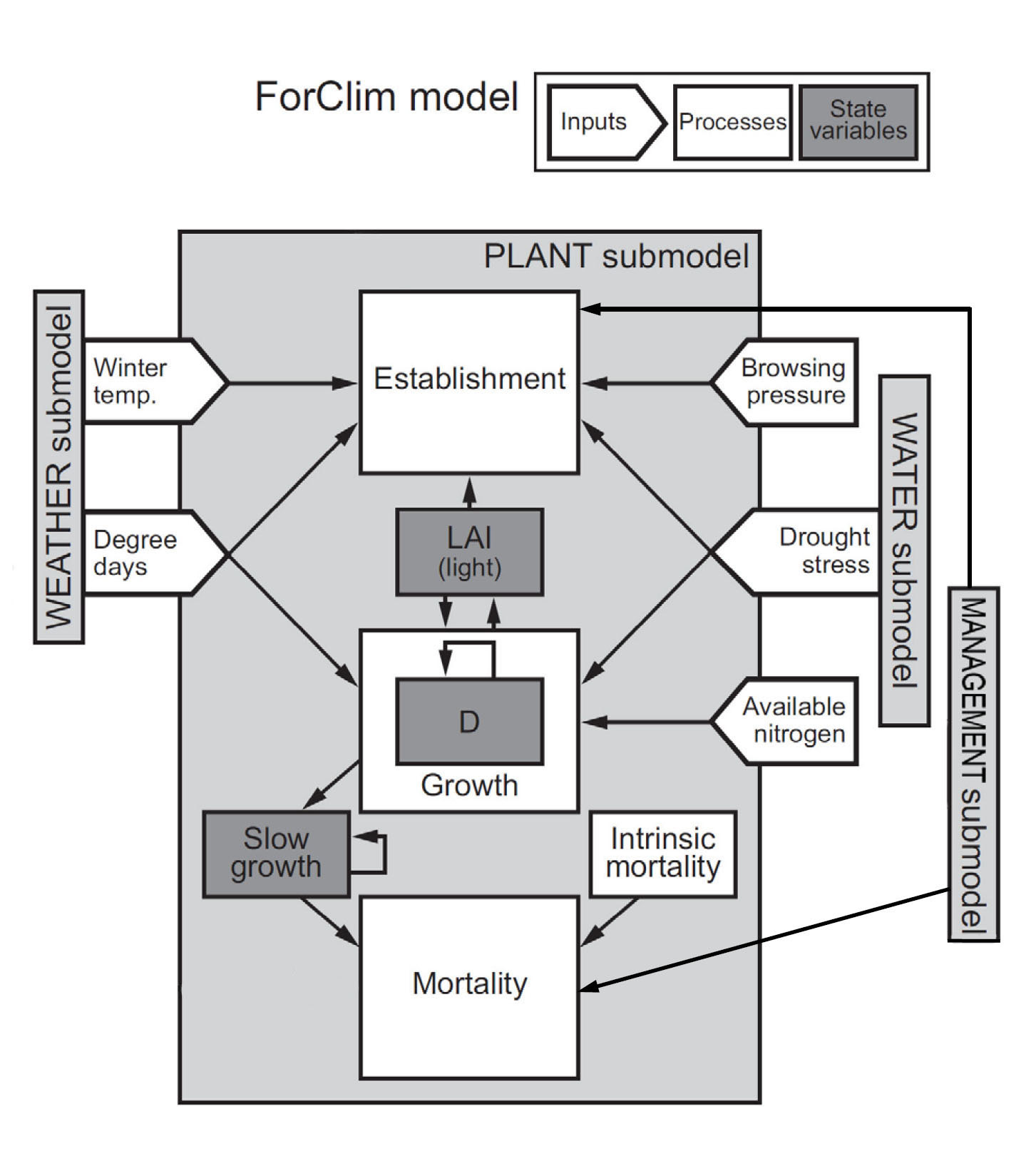
The structure of the ForClim model (modified from Rasche
The PLANT submodel simulates establishment, growth and mortality of tree individuals that, for technical reasons, are grouped in size cohorts. Tree establishment rates are determined from light availability at the forest floor, soil moisture, growing season temperature, minimum winter temperature and browsing pressure. The optimal radial stem growth rate of every tree is decreased based on the degree to which environmental
factors (growing season temperature, soil moisture, light availability, nitrogen availability) and crown size are at suboptimal levels. Tree
mortality is modeled as a combination of an age-related and a stress-induced component (Rasche, Fahse et al. 2012).
The WEATHER and WATER submodels provide the input data for the PLANT submodel. These two submodels calculate bioclimatic indices such as
minimum winter temperature, the annual sum of degree days and soil moisture based on long-term weather data and the site-specific soil water holding capacity. Values are determined from a probability distribution around the climate parameters separately for each patch.
The submodel MANAGEMENT allows simulations forest management strategies that are commonly used in Central Europe, such as clearcutting,
shelterwood, thinning, planting, among others. For a description of the management submodel, see the Supporting information in Rasche, Fahse et al. (2011).
Model applications
A selection of the most significant publications concerning the application of ForClim:
|
Explaining stand structure and species composition across three biogeographic regions of the northern Hemisphere: Generation of realistic projections of tree species composition and biomass across gradients of temperature and moisture in central Europe, eastern North America and the Pacific Northwest of the United States using one single model structure without any parameter ‘tuning’. Reference: Bugmann and Solomon (2000) Ecological Applications 10(1): 95-114. |
|
|
Exploring the implications of early senescence of CO2-fertilized trees in an ecosystem context: Elevated growth rates (e.g. induced by CO2) are likely to be coupled to reduced longevity, with unknown net consequences for the aboveground carbon balance. We showed that the two effects cancel each other under realistic assumptions of growth stimulation and longevity reduction. Reference: Bugmann and Bigler (2011) Oecologia 165(2): 533-544. |
|
|
Testing the relationship between species richness and productivity in the long term:
Short-term experiments suggest that higher species richness induces higher productivity, not only for grassland systems, but also for forests. We used FORCLIM to conduct a virtual experiment that serves to elucidate whether such a relationship also holds in the long term. Reference: Morin, Fahse et al. (2011) Ecology Letters 14(12): 1211-1219. |
|
|
Examination of the combined effects of climate change and ungulate browsing along elevation transects. Reference: Didion, Kupferschmid Albisetti et al. (2011) Climatic Change 109(3). |
|
|
Simulation of a wide range of management scenarios subject to different climatic conditions over multi-decadal to centennial time scales. Reference: Rasche, Fahse et al. (2011) Journal of Applied Ecology 48(5): 1174-1186. |
Model history
1994 FORCLIM v.2.4
Development of the forest gap model FORCLIM, test of its realism compared to its predecessor model and behavior along climate gradients in Europe and eastern North America.
Main reference: Bugmann (1996) Ecology 77(7): 2055-2074.
1998 FORCLIM v.2.6
Improved water balance model enhancing the performance of FORCLIM along drought gradients in Europe and North America.
Main reference: Bugmann and Cramer (1998) Forest Ecology and Management 103(2-3): 247-263.
2000 FORCLIM v.2.9
Modification of the widespread parabolic temperature response function to mimic non-linear increases in growth with increased temperatures up to species-specific optimal values. Introduction of growing season length and modified drought calculation differentiated for evergreen vs. deciduous species. Introduction of maximum winter warmth constraint. Test of the model applicability to the Pacific Northwest of the United States.
Main reference: Bugmann and Solomon (2000) Ecological Applications 10(1): 95-114.
2005 FORCLIM v.2.9.3
Replacementof the parabolic height-diameter relationship by an asymptotic equation, with an increase of the generality and realism of the model. Translation from original code in Modula-2 to C#.
Main reference: Risch, Heiri et al. (2005) Ecological Modelling 181(2–3): 161-172.
2007 FORCLIM v.2.9.4
First tests of the model against long-term data from Growth-And-Yield plots. Preliminary changes to the regeneration and mortality submodels to
improve their realism. Implementation of a light-dependent allometry between leaf area and DBH to account for the self-pruning in real stands.
Main reference: Wehrli, Weisberg et al. (2007) European Journal of Forest Research 126(1): 131-145.
2009 FORCLIM v.2.9.5
Improved
representation of the leaf area – DBH allometry by introducing a
feedback between leaf area per tree and diameter growth rate.
Main reference: Didion, Kupferschmid et al. (2009) Canadian Journal of Forest Research 39(6): 1092-1107.
2011 FORCLIM v.3.0
Implementation
of a detailed management submodel. Improved representation of tree
maximum height as a variable depending on climatic conditions.
Introducing tree height as a new state variable so as to allow for
differential allocation to height vs. diameter growth.
Main reference: Rasche, Fahse et al. (2011) Journal of Applied Ecology 48(5): 1174-1186;
Rasche, Fahse et al. (2012) Ecological Modelling 232(0): 133-143.
Technical information
Since version 2.9.1 of ForClim, the source code is maintained in C#, based on an earlier implementation of the model in Modula-2.
FORCLIM runs in the .NET framework on Windows PCs, and under Mono on Apple Macintosh and Linux operating systems.
FORCLIM is provided as an executable file together with a set of xml-files where all the basic settings of the simulation experiment and model parameters are managed.
FORCLIM can also be utilized via a dedicated graphical user interface, FORSIM (Figs. 2-3), which is a product of the Forest Ecology Group. Note that FORSIM is also being developed for the companion model LandClim. FORSIM allows for loading and editing setup/input files, changing settings parameters, running sequential simulations and displaying numerous results in charts and tables.

The FORCLIM set-up file using the graphical user interface (GUI) FORSIM.
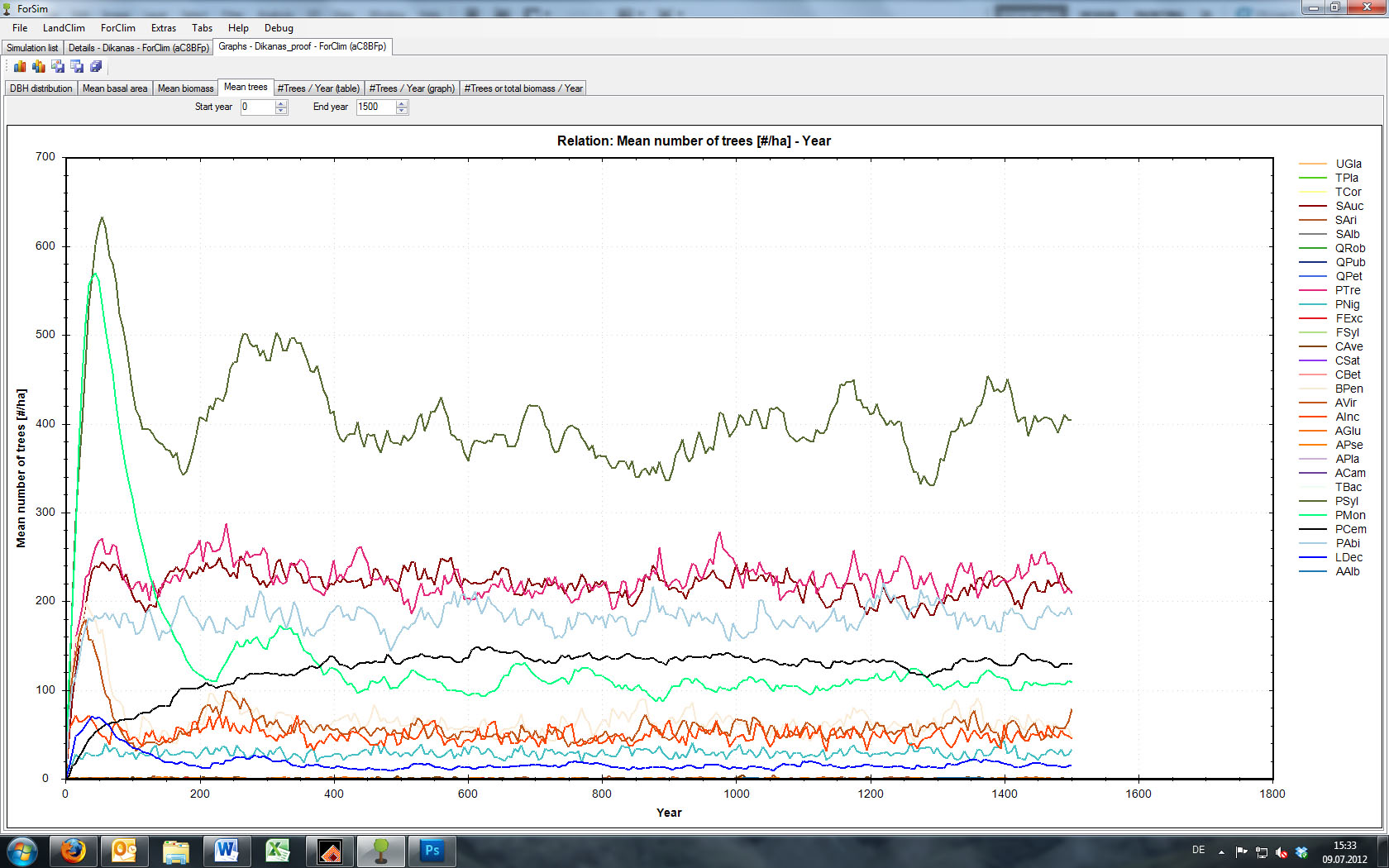
The use of FORCLIM with the graphical user interface (GUI) FORSIM.
As input data FORCLIM requires monthly averages and standard deviations of temperature and precipitation besides few site-specific parameters regarding the soil characteristics.
The standard output of FORCLIM includes aboveground biomass, productivity, basal area and tree density at both stand and species-specific level. The model output includes a mySQL database with all tree information from the entire simulation, thus allowing for calculations of DBH distributions, tree mortality rates, individual tree growth rates, etc.
References
RASCHE, L., L. FAHSE, ET AL. (2012). "Enhancing gap model accuracy by modeling dynamic height growth and dynamic maximum tree height" Ecological Modelling 232(0): 133-143.
BUGMANN, H. AND C. BIGLER. (2011). "Will the CO2 fertilization effect in forests be offset by reduced tree longevity?" Oecologia 165(2): 533-544.
DIDION, M., A. D. KUPFERSCHMID ALBISETTI, ET AL. (2011). "Ungulate herbivory modifies the effects of climate change on mountain forests." Climatic Change 109(3)
MORIN, X., L. FAHSE, ET AL. (2011). "Tree species richness promotes productivity in temperate forests through strong complementarity between species" Ecology Letters 14(12): 1211-1219.
RASCHE, L., L. FAHSE, ET AL. (2011). "Getting a virtual forester fit for the challenge of climatic change" Journal of Applied Ecology 48(5): 1174-1186.
DIDION, M., A. D. KUPFERSCHMID, ET AL. (2009). "Gaining local accuracy while not losing generality - extending the range of gap model applications." Canadian Journal of Forest Research-Revue Canadienne De Recherche Forestiere 39(6): 1092-1107.
BUGMANN, H. (2001). "A review of forest gap models." Climatic Change 51(3-4): 259-305.
BUGMANN, H. K. M. AND A. M. SOLOMON. (2000). "Explaining Forest Composition and Biomass across Multiple Biogeographical Regions." Ecological Applications 10(1): 95-114.
BUGMANN, H. (1999). "Anthropogene Klimaveränderung, Sukzessionsprozesse und forstwirtschaftliche Optionen | Anthropogenic Climate Change, Successional Processes and Forest Management Options." Schweizerische Zeitschrift fur Forstwesen 150(8): 275-287.
BUGMANN, H. AND W. CRAMER. (1998). "Improving the behaviour of forest gap models along drought gradients." Forest Ecology and Management 103(2-3): 247-263.
BUGMANN, H. K. M. (1996). "A Simplified Forest Model to Study Species Composition Along Climate Gradients." Ecology 77(7): 2055-2074.
KIENAST, F. (1987). "FORECE - a forest succession model for Southern Central Europe" Environmental Sciences Division Publication, Oak Ridge National Laboratory, Oak Ridge, Tennessee 37831, USA. Report ORNL/TM-10575
